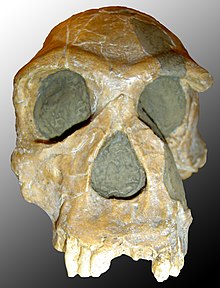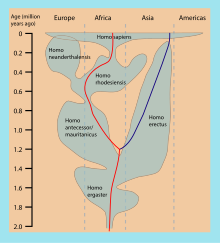Homo
| Homo | |
|---|---|

| |
| Homo habilis,the earliest member of the genus | |
| Ìṣètò onísáyẹ́nsì[e] | |
| Ìjọba: | Animalia (Àwọn ẹranko) |
| Ará: | Chordata |
| Ẹgbẹ́: | Mammalia (Àwọn afọmúbọ́mọ) |
| Ìtò: | Primates |
| Ìdílé: | Hominidae |
| Subtribe: | Hominina |
| Ìbátan: | Homo Linnaeus,1758 |
| Species | |

Homois thegenusthat includesmodern humansand species closely related to them. The genus is estimated to be about 2.3 to 2.4 million years old,[1][2]evolving fromaustralopithecineancestors with the appearance ofHomo habilis. Specifically,H. habilisis assumed to be the direct descendant ofAustralopithecus garhiwhich lived about 2.5 million years ago. The most salient physiological development between the two species is the increase incranial capacity,from about 450 cc (27 cu in) inA. garhito 600 cc (37 cu in) inH. habilis.Within theHomogenus, cranial capacity again doubled fromH. habilistoH. heidelbergensisby 0.6 million years ago. The cranial capacity ofH. heidelbergensisoverlaps with the range found in modern humans.
The advent ofHomocoincides with the first evidence ofstone tools(theOldowanindustry), and thus by definition with the beginning of theLower Palaeolithic.The emergence ofHomoalso coincides roughly with the onset ofQuaternary glaciation,the beginning of the currentice age.
All species of the genus exceptHomo sapiens(modern humans) are extinct.Homo neanderthalensis,traditionally considered the last surviving relative, died out about 24,000 years ago, while a recent discovery suggests that another species,Homo floresiensis,discovered in 2003, may have lived as recently as 12,000 years ago. The discovery ofDenisova hominin,announced in March 2010, may reveal it to be yet another species in the genus.

|
Àyọkà yìí tàbí apá rẹ̀ únfẹ́ àtúnṣe sí. Ẹ lefẹ̀ jù báyìí lọtàbí kí ẹṣàtúnṣerẹ̀ lọ́nà tí yíò mu kúnrẹ́rẹ́. Ẹ ran Wikipedia lọ́wọ́ látifẹ̀ẹ́ jù báyìí lọ. |
Itokasi
[àtúnṣe|àtúnṣe àmìọ̀rọ̀]- ↑Stringer, C.B. (1994). "Evolution of early humans". In Steve Jones, Robert Martin & David Pilbeam (eds.).The Cambridge Encyclopedia of Human Evolution.Cambridge: Cambridge University Press. p. 242.ISBN0-521-32370-3.AlsoISBN 0-521-46786-1(paperback)
- ↑McHenry, H.M (2009). "Human Evolution". In Michael Ruse & Joseph Travis.Evolution: The First Four Billion Years.Cambridge, Massachusetts: The Belknap Press of Harvard University Press. p. 265.ISBN978-0-674-03175-3.
